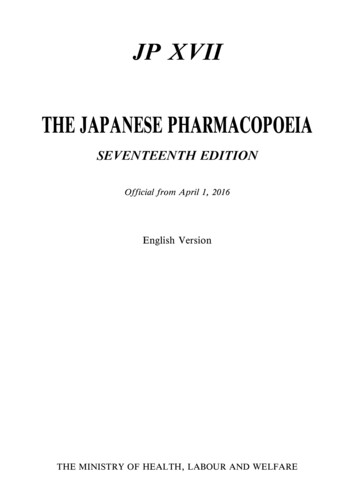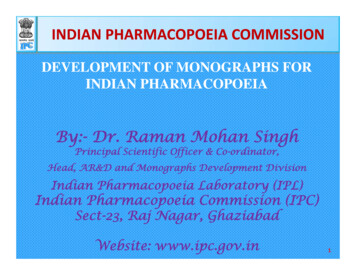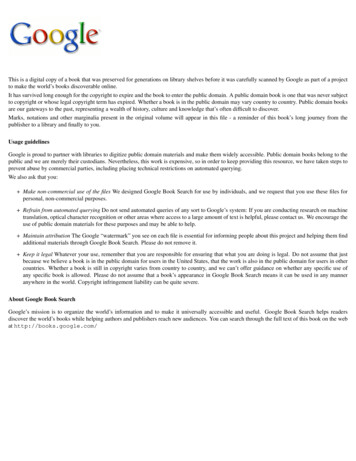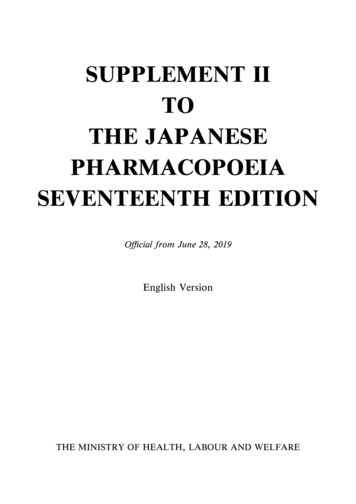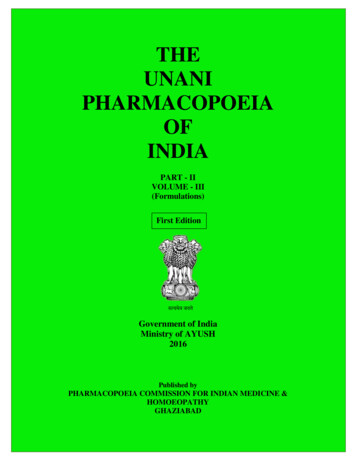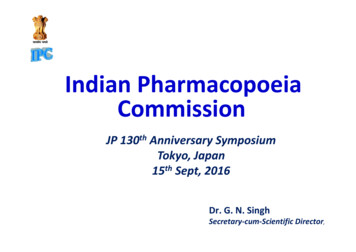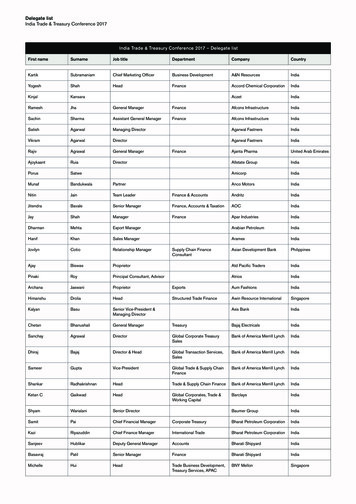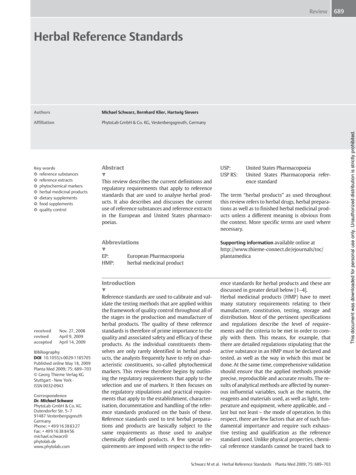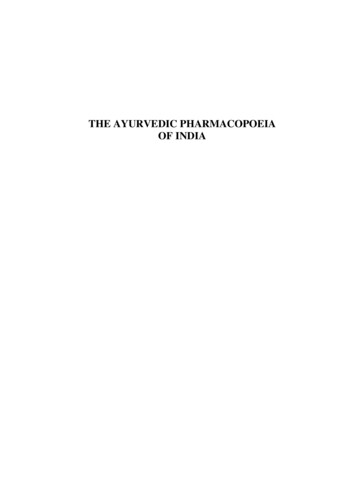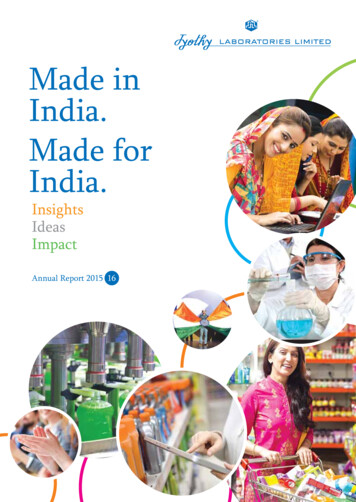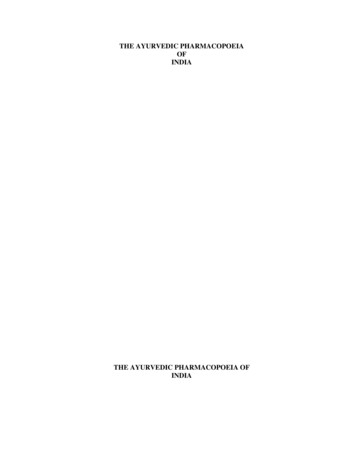
Transcription
THE AYURVEDIC PHARMACOPOEIAOFINDIATHE AYURVEDIC PHARMACOPOEIA OFINDIA
THE AYURVEDIC PHARMACOPOEIA OFINDIAPART –IVOLUME- VIFirst EditionGOVERNMENT OF INDIAMINISTRY OF HEALTH & FAMILYWELFAREDEPARTMENT OF AYUSHNEW DELHI2008II
CONTENTSPAGELEGAL NOTICE. .GENERAL NOTICE. .PREFACE.INTRODUCTION.CONTRIBUTING LABORATORIES & .42.Ādārī (Lf.)¡mragandhi-guggulu (Lf.)Ara ya-s ra a (Tuber )¡r ro a (Rz.)Asthi º khal (Aerial Part)Bh takeº (Fr.)Bh takeº (Rz.)B japatr (Wh. Pl.)Bimb (Lf.)Bimb (St.)B hat Dugdhik (Wh.Pl.)B hat (Wh.Pl.)Ca aka (Wh. Pl.)D ruharidr (Fr.)Dhava (Fr.)Dhava (St. Bk.)Dv p ntara Damanaka (Wh.Pl.)Dv p ntara ¹at var (Rt.)Elav lukam (Rt.)Elav lukam (St. Bk.)Era ²akarka (Fr.)Era ²akarka (Rt.)Gandhaºiph (Wh.Pl.)Gr ¾machatraka (Wh. Pl.)Gok¾ura (Wh. Pl.)Granthim la (Rz.)Gulad ud (Lf.)Haritama jar (Wh.Pl.)Hastiºu ² (Wh. Pl.)Ind vara (Rz.)Jalakumbh (Wh.Pl.)J vant (Rt.)Ka ak gulma (Aerial Part)Karaphs (Rt.)Ka ugulma (Wh.Pl.)Keºar ja (Wh. Pl.)Ketak (Stilt Rt.)K am r (Lf.)Kum r vetra (Rz.)Kusumbha (Fr.)Kusumbha (Lf.)Kusumbha (Fl.)Acacia pennata (L.) Willd.Balsamodendron caudata MauchSynantherias sulvatica Schott Gen.AocjaMaranta arundinacea L.Cissus quadrangularis L.Selinum vaginatum C.B. ClarkeSelinum vaginatum C.B. ClarkeAdiantum cappillus- veneris L.Coccinia grandis (L.) VoigtCoccinia grandis (L.) VoigtEuphorbia hirta L.Solanum anguivi Lam.Cicer arietinum L.Berberis aristata DC.Anogeissus latifolia Wall.Anogeissus latifolia Wall.Artemisia absinthium L.Asparagus officinalis L.Prunus avium L.Prunus avium L.Carica papaya L.Carica papaya L.Pavonia odorata Willd.Mollugo cerviana SeringeTribulus terrestris L.Alpinia calcarata Rosc.Chrysanthemum indicum L.Acalypha indica L.Heliotropium indicum L.Monochoria vaginalis PreslPistia stratiotes L.Leptadenia reticulata W.& A.Lycium barbarum L.Apium graveolens L.Toddalia asiatica (L.) Lam.Wedelia calendulacea Less non RichPandanus odoratissimus L. f.Aristolochia bracteata Retz.Calamus thwaitesii Becc.Carthamus tinctorius L.Carthamus tinctorius L.Carthamus tinctorius 5961636668707375788083868890929496
6.77.78.79.Laghu Haritamanjari (Rt.)Laghupatra-var¾ bh (Wh.Pl.)Lohitaniry sa (Exd.)M dhav (Fl.)Matsyapatrik (Wh.Pl.)Med (Rz.)N d hingu (Exd.)N h (Wh.Pl.)Nikocaka (Kernel)Panasa (Rt. Bk.)Papa ah (Rt.)Par ayav n (Lf.)Patra snuh (Latex)Pi ²a Tagara (Rz.)P ta-ka can ra (Fl.)Rakta Citraka (Rt.)Roh taka (St.Bk.)¹ la (Ht. Wd.)¹ laparni (Wh.Pl.)¹am (Lf.)Saurabhanimba (Lf.)¹itiv raka (Sd.)¹iva-n l (Rt.& St.)¹le¾m taka (Fr.)¹le¾m taka (St. Bk.)¹l pad rikanda (Tuber)Sphitak r (Rz.)Sp kk (Wh. Pl.)Sruvav k¾a (Fr.)Sth lael (Fr.)¹ukan s (Rz.)¹veta Vetasa (Lf.)Takkola (Fr.)Tinduka (Fr.)Tr yam (Rz.)Tripak¾ (Wh. Pl.)Tuvaraka (Sd.)Acalypha fruticosa Forsk.99Trianthema decandra L.101Dracaena cinnabari Balf. f.104Hiptage benghalensis L.106Merremia tridentata (L.) Hall.f.108Polygonatum cirrhifolium Royle111Gardenia gummifera L. f.113Enicostemma axillare (Lam.) A. Raynal. 115Pinus gerardiana Wall.118Artocarpus heterophyllus Lamk.120Pavetta indica L.122Coleus amboinicus Lour.124Euphorbia nivulia Buch.- Ham.127Asarum europaeum L.129Bauhinia racemosa Lamk.131Plumbago indica L.133Tecomella undulata (Sm.) Seem.135Shorea robusta Gaertn.137Desmodium gangeticum DC.139Prosopis cineraria Druce142Murraya koenigii (L.) Spreng145Celosia argentea L.148Indigofera aspalathoides Vahl ex DC.150Cordia dichotoma Forst. f.152Cordia dichotoma Forst. f.154Typhonium trilobatum Schott156Dryopteris filix-mas (L.) Schott158Anisomeles malabarica (L.) R.Br. ex Sims 160Flacourtia indica (Burm.f.) Merr.163Amomum subulatum Roxb.165Corallocarpus epigaeus Benth.ex Hook. f. 167Salix alba L.169Illicium verum Hook. f.171Diospyros peregrina Gurke173Gentiana kurroo Royle175Coldenia procumbens L.177Hydnocarpus pentandra (Buch.-Ham.)180OkenGlinus lotoides L.182Pennisetum typhoides (Burm.f.) Stapf &185C.E. Hubb.Gisekia pharnaceoides L.187Plantago lanceolata L.189Calamus rotang L.191Pergularia daemia (Forsskal) Choiv.193Garcinia pedunculata Roxb.196Doronicum hookeri C.B.Clarke198Cinnamomum zeylanicum Blume200Gaultheria fragrantissima Wall.202204Saccharum officinarum L.206208Cinnamomum camphora (L.) Nees &21080. ¾and (Wh.Pl.)81. Vajr nna (Lf.Base)82. Valuka- saka (Lf.)83. Vanya-aºvagola (Lf.)84. Vetra (Rz.)85. Visanika (Wh.Pl.)86. V ant mlaphala (Fr. Rind)87. V ºcikakanda (Rz.)88. D rusit Taila (Cinnamomum Oil)89. Gandhap ra Patra Taila90. Gogh ta (Clarified Cow’s Butter)91. Guda (Jaggery)92. Jala (Potable Water)93. Karp ra (Natural Camphor)IV
Eberm. and Ocimum kilimandscharicumGuerkeSyzygium aromaticum Merril & PerryApis sps.Mentha sps.Brassica campestris L.Eucalyptus globulus LabillSesamum indicum L.Thymus vulgaris L. and Trachyspermumammi (L.) Sprague94. Lavanga Taila (Clove Oil)95. Madhu (Honey)96. Peppermint- Satva (Menthol)97. Śarkar (Sugar)98. Sarsapa Taila (Mustard Oil)99. Tailapar a Taila (Eucalyptus Oil)100. Tila Taila (Sesamum Oil)101. Yavani Satva (Thymol)212214216218220222224226APPENDIX-11.1 Apparatus for Tests and Assays1.1.1. - Nessler Cylinder1.1.2. – Sieves1.1.3. – Thermometers1.1.4. - Ultra- Violet Lamp (For general purposes & for chromatography work)1.1.5. - Volumetric Glass War1.1.6 - Weights and Balances1.1.7 - Muslin Cloth230230230231231231231232APPENDIX -22.12.2Tests and Determinations2.1.1.- Microscopic identification 2332.1.2. – Microscopical Methods of Examining Crude Vegetable Drugs2.1.3. – Types of Stomata2.1.4. – Determination of Stomatal Index2.1.5. – Determination of Palisade Ratio2.1.6. – Determination of Vein-Islet Number2.1.7. – Determination of Stomatal NumberDetermination of Quantitative Data2.2.1.-Net Content2.2.2.-Foreign Matter2.2.3.-Determination of Toatal Ash2422.2.4.-Determination of Acid Insoluble Ash2.2.5.- Determination of Water Soluble Ash2.2.6. Determination of Sulphated Ash2.2.7.- Determination of Alcohol Soluble Extractive2.2.8.- Determination of Water Soluble Extractive2.2.9.-Determination of Ehter Soluble Extractive (Fixed Oil Content)2.2.10.- Determination of Moisture Content ( Loss on Drying)2.2.11.- Determination of Water Insoluble Matter2.2.12. -Determination of Volatile Oil in Drugs2.2.13. Special Processes Used in Alkaloidal Assays2.2.13.a. – Continuous Extraction of Drug2.2.13.b. – Tests for Complete Extraction of Alkaloids2.2.14.-Thin- Layer Chromatography 3243243244244245245245246
2.2.15.-Starch Estimation (Mont Gomery, 1957) [Spectrophotometric method]2.2.16.-Sugar Estimation (Mont Gomery,1957)[Spectrophtometric method]2.2.17.-Fatty Oil Estimation2.2.18. –Test for Argemone Oil (Mustard Oil)2.2.19.- Test for the Presence of Cottonseed Oil(Halphen Test)2.2.20. –Test for Clove Oil- Alkali- Soluble Matter2.2.21. –Test for Eucaluptus Oil2.2.22. –Determination of Acidity 2502.2.23. -Protein Estimation (Lowry et al., 1951)2.2.24.- Method for Alkaloid Estimation2.2.25.- Determination of Esters2482482492492492492492512512512.3. Limit Tests2.3.1.- Limit Test for Arsenic2,3,2.- Limit Test for Chlorides2.3.3.- Limit Test for Heavy Metals 2562.3.4.-Limit Test for Iron2.3.5.- Limit Test for Lead2.3.6.-Limit Test for Sulphates2.3.7.-Heavy Metals by Atomic Absorption Spectorphotometry2.3.8. –Determination of Lead, Cadmium, Arsenic, Mercury and Copper2.3.9.-Determination of Calcium Oxide2522522562.4. Microbial Limit Tests2.4.1.- Total Aerobic Microbial Count2.4.2.- Tests for Specified Miicro-Organisms2662752772.5. Pesticide Residue2.5.1.- Qualitative and Quantitative Analysis of Pesticide Residues2.5.2.- Test for Pesticides2.5.3.- Quantitative Analysis2802822832842.6. Gas Chromatography2862.7. Test for Aflatoxins288VI259259261261263266
APPENDIX-33.1. Physical Tests and Determinations 2903.1.1. Refractive Index3.1.2. Weight Per Millimetre and Specific Gravity3.1.3. Determination of pH Values 2912902903.2. Determination of Melting Range and Congealing Range3.2.1.- Determination of Melting Range3.2.2.- Determination of Congealing Range3.2.3.- Determination of Boiling Range2912912932943.3. Determination of Optical Rotation and Specific Optical Rotation3.4. Determination of Viscosity3.5. Determination of Total Solids3.6. Solubility in Water3.7. Determination of Saponification Value3.8. Determination of Iodine Value3.9. Determination of Acid Value3.10. Determination of Peroxide Value3.11. Determination of Unsopanifiable Matter3.12. Detection of Mineral Oil (Holde’s Test)3.13. RancidityTest (Kreis Test)3.14. Determination of Reichert Meissl And Polenske Value3.15. Determination of Alcohol NDIX- 43074.1. Reagents and SolutionsVII
APPENDIX-55.1. Chemical Tests and Assays5.1.1.- Estimation of Total Phenolic5.1.2.- Estimation of Total Tannins5.1.3.- Estimation of Sugars5.1.3.1.-Reducing sugars5.1.3.2.- Total sugars5.1.3.3.- Non-reducing sugars5.1.4.- Feihe’s Test5.1.5.- Aniline Chloride Test5.1.6.- Determination of Sulphur Dioxide5.1.7.- Determination of Total Reducing Sugars, Sucrose and Fructose-GlucoseRatio5.2. Estimation of Curcumin by TLC Densitometer5.2.1.-Determination of Aluminium5.2.2.- Determination of Borax5.2.3.- Determination of Calcium5.2.4.- Determination of Copper5.2.5.- Determination of Iron5.2.6.- Determination of Magnesium5.2.7.- Determination of Mercury5.2.8.- Determination of Silica5.2.9.- Estimation of Sodium and Potassium by Flame Photometer5.2.10.- Determination of Sodium Chloride5.2.11.- Determination of Sulphur3465.2.12.- Qualitative Reactions Some 343343344345345345345346346APPENDIX - 66.1. Weights and Measures6.1.1. –Metric Equivalents of Classical Weights and Measures3493493506.2. – Metric systemAPPENDIX - 77.1. Classical Ayurvedic References351388INDEXEnglish Equivalents of Ayurvedic Cllinical Conditions and Diseases435437439441443Monographs published in Volume – IMonographs published in Volume – IIMonographs published in Volume – IIIMonographs published in Volume – IVMonographs published in Volume – VVIII
LEGAL NOTICESIn India there are laws dealing with drugs that are the subject of monographs which follow. Thesemonographs should be read subject to the restrictions imposed by these laws wherever they are applicable.It is expedient that enquiry be made in each case in order to ensure that the provisions of the law are beingcomplied with.In general, the Drugs & Cosmetics Act, 1940 (subsequently amended in 1964 and 1982), the DangerousDrugs Act, 1930 and the Poisons Act, 1919 and the rules framed thereunder should be consulted.Under the Drugs & Cosmetics Act, the Ayurvedic Pharmacopoeia of India (A.P.I.), Part-I, Vol.VI, is thebook of standards for compound drugs included therein and the standards prescribed in the AyurvedicPharmacopoeia of India, Part-I, Vol.VI, would be official. If considered necessary these standards can be amendedand the Chairman of the Ayurvedic Pharmacopoeia Committee authorised to issue such amendments. Wheneversuch amendments are issued the Ayurvedic Pharmacopoeia of India, Part-I, Vol. VI, would be deemed to have beenamended accordingly.IX
GENERAL NOTICESTitle - The title of the book is “Ayurvedic Pharmacopoeia of India”. Wherever the abbreviation A.P.I. is used, itmay be presumed to stand for the same and the supplements thereto.Name of the Drugs - The name given on the top of each monograph of the drug is in Sanskrit as mentioned in theAyurvedic classics and/or in the Ayurvedic Formulary of India, Part-I and Part-II will be considered official. Thesenames have been arranged in English alphabetical order. The Latin name (taxonomical nomenclature) of each drugas found in authentic scientific literature has been provided in the monograph in the introductory paragraph. Theofficial name will be the main title of the drug and its scientific name will also be considered as legal name.Introductory Para - Each monograph begins with an introductory paragraph indicating the part, scientific name ofthe drug in Latin with short description about its habit, distribution and method of collection, if any.Synonyms - Synonyms of each drug appearing in each monograph in Sanskrit, English, Hindi, Urdu and otherIndian regional languages have been mentioned as found in the classical texts, Ayurvedic Formulary of India, PartI and Part-II as procured from the experts, scholars of Ayurveda and officials in the field from different states.Italics - Italic type has been used for scientific name of the drug appearing in the introductory paragraph of eachmonograph as also for chemicals and reagents, substances or processes described in Appendix.Odour and Taste - Wherever a specific odour has been found it has been mentioned but the description as‘odourless’ or ‘no odour’ has in many cases been avoided in the description, as large numbers of drugs have got nospecific odour. The “odour” is examined by directly smelling 25 g of the powdered drug contained in a package orfreshly powdered. If the odour is discernible the sample is rapidly transferred to an open container and re-examinedafter 15 minutes. If the odour persists to be discernible, it is described as having odour.The “Taste” of a drug is examined by taking a small quantity of 85 mesh powder by a tip of moist glass rodand applying it on tongue previously rinsed with water. This may not be done in case if poisonous drugs, indicatedin monograph.Mesh Number - Wherever the powdering of the drug has been required the sieve “Mesh Number 85” has beenused. This will not apply for drugs containing much oily substance.Weights and Measures - The metric system of weights and measures is employed. Weights are given in multiplesor fractions of a gramme (g) or of a milligram (mg). Fluid measures are given in multiples or fractions of millilitre(ml).When the term “drop” is used, the measurement is to be made by means of a tube, which delivers in 20drops 1 gram of distilled water at 15oC.Metric measures are required by the Pharmacopoeia to be graduated at 20oC and all measurementsinvolved in the analytical operations of the Pharmacopoeia are intended, unless otherwise stated to be made at thattemperature.Identity, Purity and Strength - Under the heading “Identification” tests are provided as an aid to identificationand are described in their respective monographs.X
The term “Foreign Matter” is used to designate any matter, which does not form part of the drug as definedin the monograph. Vegetable drugs used as such or in formulations, should be duly identified and authenticated andbe free from insects, pests, fungi, micro-organisms, pesticides, and other animal matter including animal excreta,be within the permitted and specified limits for lead, arsenic and heavy metals, and show no abnormal odour,colour, sliminess, mould or other evidence of deterioration.The quantitative tests e.g. total ash, acid-insoluble ash, water-soluble ash, alcohol-soluble extractive,water- soluble extractive, ether-soluble extractive, moisture content, volatile oil content and assays are the methodsupon which the standards of Pharmacopoeia depend. The methods for assays are described in their respectivemonographs and for other quantitative tests, methods are not repeated in the text of monographs but only thecorresponding reference of appropriate appendix is given. The analyst is not precluded from employing an alternatemethod in any instance if he is satisfied that the method, which he uses, will give the same result as thePharmacopoeial Method. In suitable instances the methods of microanalysis, if of equivalent accuracy, may besubstituted for the tests and assays described. However, in the event of doubt or dispute the methods of analysis ofthe Pharmacopoeia are alone authoritative.Standards - For statutory purpose, statements appearing in the API, Part-I, Vol. V, under Description, those ofdefinition of the part and source plants, and Identity, Purity and Strength, shall constitute standards.Thin Layer Chromatography (T.L.C.) - Under this head, wherever given, the number of spots and Rf values ofthe spots with their colour have been mentioned as a guide for identification of the drug and not as Pharmacopoeialrequirement. However, the analyst may use any other solvent system and detecting reagent in any instance if he issatisfied that the method which he uses, even by applying known reference standards, will give better result toestablish the identity of any particular chemical constituent reported to be present in the drug.Quantities to be Weighed for Assays and Tests - In all description quantity of the substance to be taken fortesting is indicated. The amount stated is approximate but the quantity actually used must be accurately weighedand must not deviate by more than 10 per cent from the one stated.Constant Weight - the term “Constant Weight” when it refers to drying or ignition means that two consecutiveweighings do not differ by more than 1.0 mg per g of the substance taken for the determination, the secondweighing following an additional hour of drying on further ignition.Constituents - Under this head only the names of important chemical constituents, groups of constituents reportedin research publications have been mentioned as a guide and not as pharmacopoeial requirement.Percentage of Solutions - In defining standards, the expression per cent (%), is used, according to circumstances,with one of the four meanings given below.Per cent w/w (percentage weight in weight) expresses the number of grammes of active substance, in 100grammes of product.Per cent w/v (Percentage weight in volume) expresses the number of grammes of active substance in 100millilitres of product.Per cent v/v (percentage volume in volume) expresses the number of millilitres of active substance in 100millilitres of product.Per cent v/w (percentage volume in weight) expresses the number of millilitres of active substance in 100grammes of product.XI
Percentage of alcohol - All statements of percentage of alcohol (C2H5OH) refer to percentage by volume at 15.56oC.Temperature - Unless otherwise specified all temperatures refer to centigrade (celsius), thermometric scale.Solutions - Unless otherwise specified in the individual monograph, all solutions are prepared with purified water.Reagents and Solutions - The chemicals and reagents required for the test in Pharmacopoeia are described inAppendices.Solubility - When stating the solubilities of Chemical substances the term “Soluble” is necessarily sometimes usedin a general sense irrespective of concomitant chemical changes.Statements of solubilities, which are expressed as a precise relation of weights of dissolved substance ofvolume of solvent, at a stated temperature, are intended to apply at that temperature. Statements of approximatesolubilities for which no figures are given, are intended to apply at ordinary room temperature.Pharmacopoeial chemicals when dissolved may show slight physical impurities, such as fragment of filterpapers, fibres, and dust particles, unless excluded by definite tests in the individual monographs.When the expression “parts” is used in defining the solubility of a substance, it is to be understood to meanthat 1 gramme of a solid or 1 millilitre of a liquid is soluble in that number of millilitres of the solvent representedby the stated number of parts.When the exact solubility of pharmacopoeial substance is not known, a descriptive term is used to indicateits solubility.The following table indicates the meaning of such terms :Descriptive termsVery solubleFreely solubleSolubleSparingly solubleSlightly solubleVery slightly solublePractically insolubleRelative quantities of solventLess than 1 part.From 1 to 10 parts.From 10 to 30 parts.From 30 to 100 parts.From 100 to 1000 parts.From 1000 to 10,000 parts.More than 10,000 parts.Therapeutic Uses and Important Formulations – Therapeutic uses and important formulations mentioned inthis Pharmacopoeia are, as provided in the recognised Ayurvedic classics and in the AyurvedicFormulary of India, Part –I and Part-II.Doses –The doses mentioned in each monograph are in metric system of weights, which are the approximateconversions from classical weights mentioned in Ayurvedic texts. A conversion table is appendedgiving classical weights of Ayurvedic System of Medicine with their metric equivalents. Dosesmentioned in the Ayurvedic Pharmacopoeia of India (A.P.I.) are intended merely for generalguidance and represent, unless otherwise stated, the average range of quantities per dose which isgenerally regarded suitable by clinicians for adults only when administered orally.XII
It is to be noted that the relation between doses in metric and Ayurvedic systems set forth in the text is ofapproximate equivalence. These quantities are for convenience of prescriber and sufficiently accurate forpharmaceutical purposes.XIII
Abbreviations of Technical Terms – The abbreviations commonly employed are as follows:mlmm.cm.µKg.g.mg.ml.IN.0.5 N0.1 N1M.Fam.PS.TS.MetreLitreMillimetreCentimetreMicron (0.001 mm)KilogramGrammeMilligramMillilitreNormal solutionHalf-normal solutionDecinormal solutionMolar solutionFamilyPrimary StandardsTransverse breviations Used for .Ori.Puj.Tam.Tel.XIV
PREFACE1. India, due to its unique variety of geographical and climatic factors, has a rich and varied flora ofmedicinal plants since the dawn of civilization. No wonder that out of a total number of over 15,000 plant speciesin India about 2000 are known to have medicinal properties and some of them are used as home-remedies in therural and remotest parts of the country.2. The vastness of the country with its inadequate means of communication and facilities for transport ofdrugs coupled with diverse regional languages, gave rise to a multitude of synonyms (names in regional languagesfor one species). Further, Ayurveda, being a dynamic professional science, led to the successful use of severalnewer drugs with therapeutic values similar to those which were originally equated with the classical Ayurvedicdrugs. These later assumed the name of the very same classical drug and continued to be locally collected, soldand used in that name since the main drug was locally unavailable and substitution became a necessity. Later, inthe first half of the century, while scientifically identifying the drugs in vogue in different regions, scientists foundthat there were more than one species, belonging even to different families of plants, claiming the same classicalname of the Ayurvedic drug. ‘Brahmi’ could be cited as a good example. This created an impression that thereexisted a great controversy about the real identity of Ayurvedic drugs. Such drugs, were stamped as “controversialdrugs” without examining their potential as therapeutic equivalents.3. Ayurveda had never been static. Its practitioners had been innovative and dynamic in therapeuticpractice and tried out drugs from the local flora to discoverer newer medicines with the same therapeutic value asthe classical drugs. These newer drugs were accepted by the then practising profession as “substitutes”. A study ofAyurvedic literature, reveals several references permitting the use a substitute drug when the classical drug is notavailable. Such recommendations are based on its therapeutic equivalence, clinical efficacy, and on equivalentstatus of their Rasa, Guna, Virya, Vipaka and Karma.4. A few classical drugs of Himalayan origin were limited and seasonal in their occurrence. They could notbe grown on plains and hence their use was restricted. By the time they were identified their supply had dwindledand commercial substitution started. These drugs are the “Sandigdha Dravyas” (drugs of doubtful identity) one ofwhich is the ‘Ashta Varga’, consisting of 8 Single Drugs.5. During the last 100 years of the alien rule social and economic conditions in India changed due to ofurbanisation. Ayurvedic physicians took to cities and lost their contact with forests where their drug sources lay. Asa consequence of better transport facilities, trade in crude drugs became easier and suppliers came between theAyurvedic physician and his personal collection of herbs. Commercial manufacture of Ayurvedic Medicines infactories started. These were the inevitable consequences of the socio-economic changes in the country. The neweconomic set up was such that the Ayurvedic practitioner could no longer process and prepare his own medicinesbut had to depend on the big pharmaceutical houses and the suppliers of crude drugs to whatever extent he neededthem. There was, in a way, a forced division of labour where he had no choice but to purchase his drugs and nomeans to ascertain the authenticity of the medicines and formulations offered to him by the pharmaceutical houses,nor was there any Governmental control on the manufacture to ensure the quality of the medicines marketed,prescribed and administered to his patient.6. As an outcome of the first Health Minister’s Conference of 1946, a Committee under the Chairmanshipof Lt. Col. R.N. Chopra was appointed in 1946 by the Government of India. It was the Chopra Committee that hadfirst gone into the question of need for proper identification of Ayurvedic medicinal plants, control over collectionand distribution of crude drugs and made positive recommendation for compilation of an AyurvedicPharmacopoeia. Thereafter, the Dave Committee (1955) reiterated the recommendations for compilation of anAyurvedic Pharmacopoeia.7. The Government of Bombay, was specially interested in the survey of resources of Ayurvedic Drugs,their collection, cultivation, farming, distribution and standardization. They, therefore had appointed a Committeefor Standard and Genuine Ayurvedic Herbs and Drugs in 1955 and subsequently after receiving its report withfresh set of terms of reference, appointed a second committee called the Committee for Standard Ayurvedic Herbsand Drugs in 1957 both under the Chairmanship of Vaidya Bapalal Shah, of which Professor A.N. Namjoshi wasthe Member Secretary. The Bapalal Committee had very elaborately recommended the compilation of theAyurvedic Pharmacopoeia as an urgent prerequisite for effective control of Ayurvedic Drugs to ensure qualityXV
assurance. Finally Government of India appointed the “Ayurvedic Research Evaluation Committee”, under theChairmanship of Dr. K.N. Udupa (1958) which had strongly highlighted the urgency of the compilation of anAyurvedic Pharmacopoeia.8. In compliance with some of these recommendations, the Union Government as also some of the StateGovernments had started taking positive steps. The Government of Bombay State established its Board of Researchin Ayurveda, Bombay in 1951, which was subsequently reconstituted in 1955 and 1958. The Government of Indiaestablished CCRIMH in 1969 for research in all aspects including drug standardisation in Indian Medicine &Homoeopathy. This Council was divided into 4 research councils in 1978 and the research work in Ayurveda andSiddha was entrusted to the Central Council for Research in Ayurveda & Siddha. The PLIM, at Ghaziabad wasestablished in 1970 for testing and standardisation of single drugs and compound formulations. Under the auspicesof the Central Council for Research in Ayurveda and Siddha, several survey units in different States wereestablished and work of standardisation of single drugs and compound medicines as also composite research workwas initiated. The first Ayurvedic Pharmacopoeia Committee was constituted in 1962 under the Chairmanship ofCol. Sir Ram Nath Chopra. The Committee was reconstituted in 1972 under the Chairmanship of Prof. A.N.Namjoshi which took over the work of compilation of the Ayurvedic Formulary of India as a pre-requisite forunder taking the work of Ayurvedic Pharmacopoeia of India.9. After publication of the First and the Second part of the Ayurvedic Formulary of India, Part-III of theFormulary is under preparation. A list of single drugs, which enter into the formulations, has been prepared.Collection of data from published material and from experimental work in collaborative laboratories to producenecessary data is being done under the auspices of the Ayurvedic Pharmacopoeia Committee.10. The First and Second Part of the Ayurvedic Formulary of India comprising of some 444 and 191formulations respectively cover more than 351 single drugs of plant origin. This is part of about 500 priority drugsof plant origin to come within the ambit of the Ayurvedic Pharmacopoeia of India.11. While systematic efforts are on to introduce quality control, over the ayurvedic drugs during the postindependence period, it is interesting to note that the great strides made by the western or modern system ofmedicine, with its formidable armoury of synthetic drugs, chemo-therapeutic agents and antibiotics, are slowingdown gradually with the realization of their adverse effects causing damage to the human systems. The westernworld is coming to accept the value of herbal medicines, appreciate and understand the basic philosophy ofAyurveda, which initially appeared to be rather abstract and difficult to interpret in terms of modern medicalsciences.12. With the introduction of legislative measures for quality control, a process initiated some 50 years ago,there w
the ayurvedic pharmacopoeia of india . ii the ayurvedic pharmacopoeia of india part -i volume- vi first edition government of india ministry of health & family welfare department of ayush new delhi 2008 . iii contents page legal notice . . . . . . ix general notice . . . . . . .
